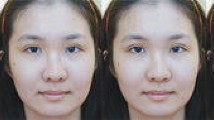Abstract
Background
The mechanism underlying the formation of upper eyelid creases has been the subject of extensive study and ongoing debate. This research aims to elucidate the principles of upper eyelid creases formation, leveraging the membrane bending theory from engineering mechanics.
Methods
We developed an anatomical model of the eyelid and implemented the finite element analysis. Preprocessing and mesh division were conducted using HyperMesh, followed by computational analysis with Abaqus. This approach enabled the observation of dynamic changes in the upper eyelid during eye opening and closing.
Results
The study reveals that natural upper eyelid crease formation is influenced by multiple factors. These include the softer texture of the upper eyelid skin and the suborbicularis oculi fat, reduced rigidity at the eyelid crease, optimal contraction force of the upper eyelid, and the strategic placement of the pre-tarsal fat pad just above the eyelid crease.
Conclusions
Ultimately, our findings demonstrate the effectiveness of finite element analysis, grounded in membrane bending theory, in elucidating the dynamics of upper eyelid crease formation.
Level of Evidence IV
This journal requires that authors assign a level of evidence to each article. For a full description of these Evidence-Based Medicine ratings, please refer to the Table of Contents or the online Instructions to Authors www.springer.com/00266.
















Similar content being viewed by others
References
Sayoc B (1956) Absence of superior palpebral fold in slit eyes; an anatomic and physiologic explanation. Am J Ophthalmol 42:298–300
Choi Y, Kang HG, Nam YS (2017) Three skin zones in the Asian upper eyelid pertaining to the asian blepharoplasty. J Craniofac Surg 28(4):892–897
Li B, Cao Y-P, Feng X-Q, Gao H (2012) Mechanics of morphological instabilities and surface wrinkling in soft materials: a review. Soft Matter 8:5728–5745
Saonanon P, Thongyong P, Wongwuticomjon T (2016) Differences between single and double eyelid anatomy in Asians using ultrasound biomicroscopy. Asia Pac J Ophthalmol (Phila) 5(5):335–338
Hwang K, Kim DJ, Hwang SH (2006) Thickness of Korean upper eyelid skin at different levels. J Craniofac Surg 17:54–56
Hwang K, Kim DJ, Chung RS, Lee SI, Hiraga Y (1998) An anatomical study of the junction of the orbital septum and the levator aponeurosis in orientals. Br J Plast Surg 51:594–598
Cheng J, Feng-Zhi Xu (2001) Anatomic microstructure of the upper eyelid in the oriental double eyelid. Plast Reconstr Surg 107:1665–1668
Most SP, Mobley SR, Larrabee WF Jr (2005) Anatomy of the eyelids. Facial Plast Surg Clin North Am 13:487–492
LiangliangZhu XC (2013) Mechanical analysis of eyelid morphology. Acta Biomater 9:7968–7976
Ciarletta P, Amar MB (2012) Papillary networks in the dermal-epidermal junction of skin: a biomechanical model. Mech Res Commun 42:68–76
Jeong S, Lemke BN, Dortzbach RK et al (1999) The Asian upper eyelid: an anatomical study with comparison to the Caucasian eyelid. Arch Ophthalmol 117:907–912
Dunn MG, Silver FH, Swann DA (1985) Mechanical analysis of hypertrophic scar tissue: structural basis of apparent in-creased rigidity. J Invest Dermatol 84:9–13
Funding
This work was supported by the following grants: Nantong Science and Technology Development Plan Project MS2023043 (to C.C.Z).
Author information
Authors and Affiliations
Corresponding author
Ethics declarations
Conflict of interest
No potential conflict of interest was reported by the authors.
Ethical Approval
All procedures performed in studies involving human participants were in accordance with the ethical standards of the institutional and/or national research committee and with the 1964 Helsinki Declaration and its later amendments or comparable ethical standards.
Informed Consent
For this type of study, informed consent is not required.
Additional information
Publisher's Note
Springer Nature remains neutral with regard to jurisdictional claims in published maps and institutional affiliations.
Rights and permissions
Springer Nature or its licensor (e.g. a society or other partner) holds exclusive rights to this article under a publishing agreement with the author(s) or other rightsholder(s); author self-archiving of the accepted manuscript version of this article is solely governed by the terms of such publishing agreement and applicable law.
About this article
Cite this article
Qiao, Q., Zhong, CC. & Zhuang, YY. Thin-Film Buckling Theory and Clinical Application of the Mechanism of Double Eyelid Formation. Aesth Plast Surg (2024). https://doi.org/10.1007/s00266-024-04085-z
Received:
Accepted:
Published:
DOI: https://doi.org/10.1007/s00266-024-04085-z




